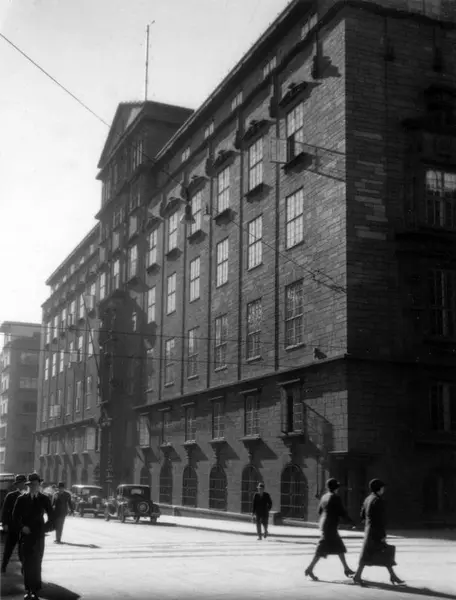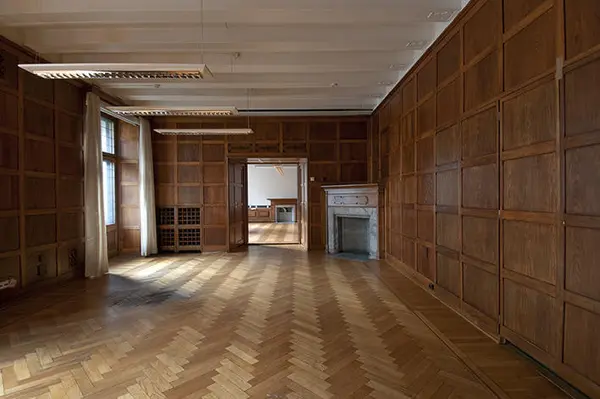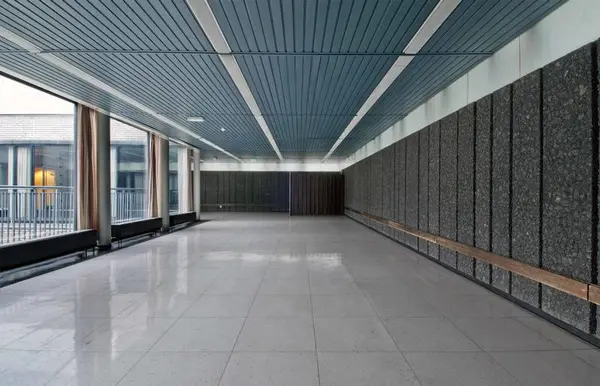The task of the Directorate for Cultural Heritage is to counsel the municipality in questions regarding the preservation of buildings with an architectural or cultural value. When it comes to the matter of the Telegraph building in Kongens Gate 21, she is, in her own words: “Exhilarated and thrilled.”
-It’s of a very high architectural value. Only a few days ago, I posted images of some lovely details from there on Instagram. Look!
Janne Wilberg whips out her mobile phone and swipes out images of the Telegraph building’s façade. Here is the municipality’s coat of arms, Norway’s coat of arms and other ornaments chiselled into the granite.
-It’s almost possible to read the façade, from detail to detail, and see how Norway is bound together in this building, through its decorations program.
-Has it been well thought through?
-Down to the smallest detail. It really is wonderful.
The very conscious choice of form is typical to the architects behind this building, tells Wilberg.
-Arnestein Arneberg and Magnus Poulsson had an eye for details, and were very mindful of the use of quality materials. They did of course also design the new Oslo City Hall, another extraordinary building, she smiles.
-What is interesting about Kongens Gate 21 is that it’s a kind of hybrid. Nordic neo-baroque was the stylistic ideal of the day, where inspiration was gathered from ancient Swedish fortifications and translated it into an Oslo setting. In this building, the Norwegian expression has been emphasised producing a sort of “Saga-effect.” That is probably why they have covered the brick façade in spot-chiselled Labrador stone.
-
The telegraph building, 1930ties Ukjent/Telemuseet
A monument of a new sector’s self-awareness
You’ll have to stand pretty close to the Telegraph building to be able to see the lovely details on its façade. At first sight it seems more like a colossus. In some ways the building resembles a solid rock face, or an impregnable city wall. It is heavy, and serious. You certainly get the feeling that something important has been going on here.
-It really signals “Here we come,” nods Wilberg.
-The building manifests its importance to society. It is a monument of a new sector’s self-awareness. It was decided to build the Telegraph building in 1916, and in 1922 it was finished. We had just been through the First World War, and seen the importance of communications across countries and continents. This task deserved a powerful building, she says, and sketches out the historic lines:
-What characterizes the 1900s? Structural change. We got hydro-electric power. Due to the emergence of the aircraft and other new means of transport, the world became a smaller place. The Telegraph building falls into this development; it connected Norway to the world abroad. The place also had an emergency function. If something happened, it was from this place events would be handled. In today’s terms it was meant to function as a so called “hub.”
-So this was Norway’s action centre?
-Yes. This was where the messages arrived. Norway is at war. The King is dead. There were also all the small stories concerning the life of normal people, and about those who had their loved once abroad. Today we can use Facebook, we skype and call directly, but in those days, such things cost lots of money. You would have to visit the Telegraph building, order the call, and wait for it to be connected. There are images of people sitting at Kongens Gate 21, waiting. “Yes, it’s ready. Go to booth 15.” And there you would finally be connected to your auntie Augusta in Miami.
When operations were shut down in the 1990s, more than one million cables were removed, tells Wilberg.
-And I’m not lying, one million! I saw those cables with my own eyes. Underneath the raised floors there was an absolute mass of cables. The cables have been tidied away and removed in large parts of the facility, so now only the building related qualities remain. And it is those which will have to tell the story in the future, next to the images featuring “life at the telegraph.”
-
Detail of fresco by Alf Rolfsen Cato Normann/Telemuseet
Protection of meaningful elements
And here we are at the core of the Directorate of Cultural Heritage’s interest for the Telegraph building. Wilberg will make sure meaningful elements will be preserved now that the building is to be sold, and adapted for further service. On the question of what could be the “meaningful elements” in Kongens Gate 21, she mentions the service hall with frescoes by Alf Rolfsen, the stairwell with the chandelier and the General Director’s office.
-A General Director at Televerket wasn’t just anybody. Practically, he had opportunities to take part in controlling the country’s development. This status is visible in his office, she says.
-The 60s part is also incredibly beautiful. The Directorate for Cultural Heritage has also evaluated this to be worthy of protection. The ambience in a facility like the Telegraph building is quite special. This was a female dominated work place, so it also represents exciting women’s history.
The façade should be kept “as is,” says the Directorate for Cultural Heritage. It displays, among other things, the particular security measures taken around this the stronghold of telecommunication:
-For security reasons the windows on the ground floor were installed high up on the wall, and covered in grating. Further use must involve preserving some of these fantastic grates. Similarly to bank buildings which were constructed as giant vaults, they tell a story. This is why we have clearly stated that the façade with the window distribution that can be seen today will have to be respected also in the future.
Want to open the building
-What are your thoughts around the sale of Kongens Gate 21?
-Well, it has already been put up for sale once. On that occasion we noticed that the prospects that were made for the sale of the building went very far past what is considered acceptable in the opinion of the Directorate for Cultural Heritage. Even if there is major potential for development here, some main premises will have to be laid down at base level. The main potential is actually inside the building complex, where there are quite a lot of newer structures which could be removed or changed.
-So the Directorate for Cultural Heritage is taking a keen interest in the process?
-Yes, and we received an enormous amount of inquiries when it was put up for sale. The result was that we wrote a comprehensive report on the building’s value as an object of cultural heritage and sent it to the estate agent and the ten involved parties we had been in contact with. It is crucial for new owners and building companies to know what to expect.
The Directorate for Cultural Heritage can’t give information to single, potential buyers, tells Wilberg. The information must be made available to everyone. She also points out that the cultural heritages act does not regulate the building’s use; only use which is significantly damaging to the value as cultural heritage.
-So we can wish for a certain type of usage, but we can’t control it. But of course, if someone asks: “Do you think this usage is more suitable than that,” we would offer a reasoned opinion.
-What are your hopes for the building?
-First and foremost that the new owners respect the conservational values in the further development of the building, she says.
-Many alternatives have already been investigated, and in my opinion one of the most important aspects in the coming time is that all of us, the citizens of Oslo, get access to parts of these beautiful, representative premises. Not least to the frescoes indoors.
None of this means that the Directorate for Cultural Heritage is against further development, and new operations in the venerable, old building. On the contrary:
-There are so many fine qualities which can be highlighted and exploited, also in a commercial context. This is why we haven’t only been giving a statement concerning the limitations, but also for the possibilities. There are quite a lot of potential inside. Up in the storeys you have the great halls where the telephone operators sat by their switchboards. These can be demanding spaces due to their depth, but of course there are a lot of things that could be done there. It has been considered for educational use, but I think the conclusion was that it wasn’t particularly suitable for that purpose.
- 1/2
Telegraph director's office, 3rd floor Cato Normann/Telemuseet - 2/2
From top floor Cato Normann/Telemuseet
The synergy within the quarter
-What are your thoughts concerning the synergy to the other buildings in this quarter?
-We know that the area is in need of more life. This is why we have been positive to the project in Sentralen where we have participated in facilitating new and changed usage.
“Sentralen” is the old Christiania Sparebank (bank) in Øvre Slottsgate. It was reopened as a culture- and innovation centre in February 2016, and is today housing more than 350 creative people.
-This is an important factor in keeping people in the area outside of working hours, means Wilberg.
-It’s true; it’s very empty here after work hours…
-Yes, and one reason for that is probably that few people live here, but also that several of the streets in the area are narrow and lined with tall buildings. It’s more attractive to sit at Christiania Torg, or in streets with lower volumes. Nevertheless, it is desired that at least the ground floor contains some activity that is inviting, because it is the business and not the building that decides if you experience the premises as closed off or open. It’s all about what we signal through the windows, and whether the activities there are of an inviting nature.
-What do you mean by “outward facing activities?”
-It could mean many things, everything from clothes shops and restaurants to writing workshops and pop-up events. The Telegraph building is so big, however, that I would probably advice on a differentiated use, says, Janne Wilberg.
-Would you care to make a guess at what this will end up as?
-I would have thought that parts of the building would be suitable for a hotel business.




